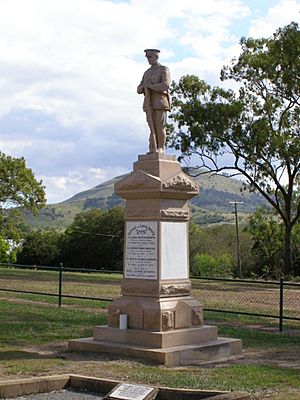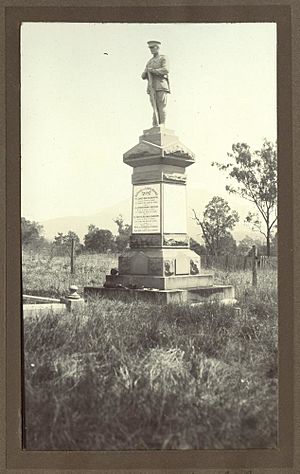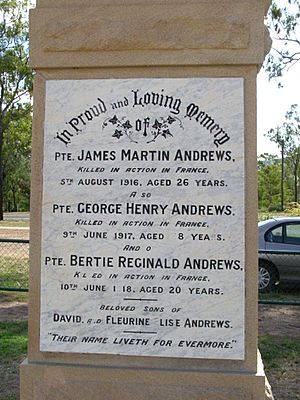Ma Ma Creek War Memorial facts for kids
Quick facts for kids Ma Ma Creek War Memorial |
|
|---|---|

War memorial in the grounds of St Stephen's Anglican Church cemetery at Ma Ma Creek, 2006
|
|
| Location | Gatton Clifton Road, Ma Ma Creek, Queensland, Australia |
| Design period | 1919 - 1930s (interwar period) |
| Built | 1920 |
| Built for | Fleurine Elsie Andrews |
| Architect | Andrew Lang Petrie |
| Official name: Ma Ma Creek War Memorial | |
| Type | state heritage (built) |
| Designated | 21 October 1992 |
| Reference no. | 600514 |
| Significant period | 1920-(social) 1920(historical, fabric) |
| Significant components | cemetery, memorial - soldier statue |
| Builders | Andrew Lang Petrie |
| Lua error in Module:Location_map at line 420: attempt to index field 'wikibase' (a nil value). | |
The Ma Ma Creek War Memorial is a special monument located on the Gatton-Clifton Road in Ma Ma Creek, Queensland, Australia. It was finished in 1920. This memorial is listed on the Queensland Heritage Register because it is an important part of Queensland's history and culture.
Contents
Remembering Our Heroes
The Ma Ma Creek War Memorial was built in 1920. A woman named Fleurine Elsie Andrews asked for it to be made. It was designed and created by a company called A. L. Petrie and Son from Toowong, Brisbane.
A Mother's Tribute
Fleurine Elsie Andrews had a very sad reason for building this memorial. She lost three of her sons during World War I. They were:
- Private James Martin Andrews (who died on August 5, 1916, at age 26)
- Private George Henry Andrews (who died on June 9, 1917, at age 28)
- Private Bertie Reginald Andrews (who died on June 10, 1918, at age 20)
All three brothers were killed in France. To remember them, Fleurine Elsie Andrews also gave an organ to the local church.
The Meaning of War Memorials
Before World War I, Australia did not have many public monuments. But after the war, many memorials were built. They showed how much the war affected the young country. Australia lost about 60,000 people from a population of only 4 million. This was a huge loss.
These memorials were like sacred places. They were like graves for the Australians whose bodies were buried far away in Europe and the Middle East. The word "cenotaph" means "empty tomb." It was often used for war memorials because they honored those buried elsewhere.
Australian war memorials are special because they don't just remember the dead. They also honor everyone who served from a local area. This is because Australia's army was made up entirely of volunteers. These memorials show how much communities were involved in the war effort.
The "Digger" Statue
In Queensland, the "digger" statue was a very popular type of war memorial. A digger statue shows a soldier, often with his head bowed. It represents the ANZAC spirit and the qualities of an ideal Australian soldier: loyalty, courage, and youth.
A. L. Petrie and Son, who made the Ma Ma Creek memorial, was the biggest company for making monuments in Queensland at that time. They created many war memorials across the state. The Ma Ma Creek memorial is unique because its digger statue wears a cap instead of the usual slouch hat.
About the Memorial
The Ma Ma Creek War Memorial is located in St Stephen's cemetery. This cemetery is on the Gatton-Clifton Road, right next to the State School. It's a small country cemetery. The memorial is placed in the Andrews family's burial plot. It stands out and can be easily seen from the road.
What It Looks Like
The memorial is made of sandstone. It has a pedestal (a base) with a digger statue on top. The base has two steps. On top of the steps is a block with rough surfaces. This block has smooth plaques on each side. The name "A L PETRIE" is carved on the front.
The main part of the memorial is a smooth square pillar. It has marble plaques on the front and sides. The front plaque has a design of an ivy leaf. It also lists the names and details of the three Andrews brothers who died in World War I. The digger statue stands on a double step.
The digger statue is life-sized. It shows a soldier with his head bowed, holding a rifle upside down. As mentioned, this digger is special because he wears a cap instead of a slouch hat. A tree stump behind him helps support the statue.
Why It's Important
The Ma Ma Creek War Memorial was added to the Queensland Heritage Register on October 21, 1992. It is important for several reasons:
A Part of History
This memorial helps us understand Queensland's history. It shows how war memorials became a common way for communities to remember the huge impact of World War I. It also shows how deeply families were affected by the war.
A Unique Memorial
This digger statue is special because it wears a cap, which is uncommon. It is also a rare example of a memorial built by a private family (the Andrews family) and placed in a cemetery.
Showing Design and Craftsmanship
The memorial shows the typical design of monuments from the time between the two World Wars. It is a good example of a structure built to remember a major historical event. The materials and design are well-chosen. As a digger statue, it represents the most popular type of memorial in Queensland.
Beautiful and Meaningful
The memorial is beautiful and stands out in the country churchyard. It shows high-quality workmanship and design.
Special Connections
This memorial has a strong connection to the Andrews family, who built it after losing their three sons. It also has a special meaning for the local community. It is a central place for public remembrance services, like ANZAC Day.
The memorial also shows the excellent work of the monumental masonry company A. L. Petrie and Son. It is a well-preserved example of their craftsmanship.



